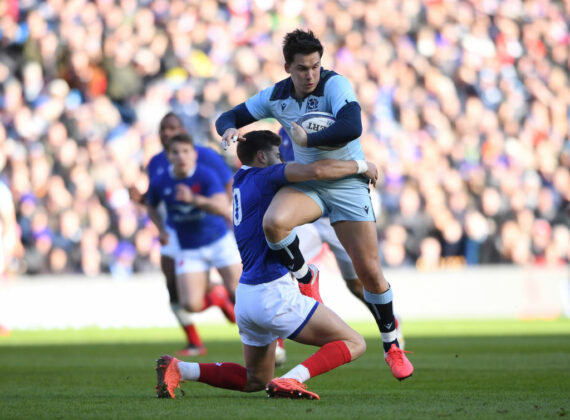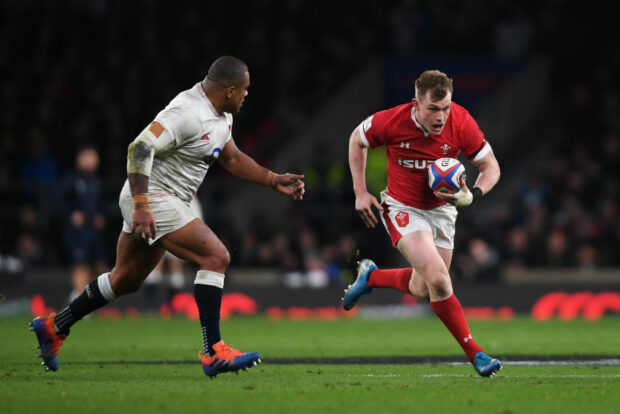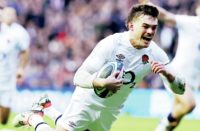The most exciting midfield in this season's Six Nations, at least in prospect, was the French. When their side was announced to play England my first thought was that a 10-12-13 combination of Romain Ntamack, Virimi Vakatawa and Gael Fickou was a mouthwatering trio.
That's because Ntamack is a relatively quick fly-half who can play flat and attract defenders as he has too much pace to be left alone, which in turn provides space for his centres.
In Vakatawa and Fickou he had two centres outside him with pace and power, which gives any fly-half a safety net, and because Ntamack has played mainly at centre for Toulouse he knows exactly when and how they want the ball.
Even when Fickou moved out to the wing and Arthur Vincent came in at 13, there was not much change, because, although Vincent is not the biggest he is strongly built, like his Welsh counterpart Nick Tompkins, and packs a punch.
However, although the French had plenty of midfield threat, they still played too much as individuals to make the most of it, and my feeling is that because they did not bed-in the Ntamack-Vakatawa-Fickou partnership, in the end were not as potent as they could have been.
One of the problems – and it does not apply only to France – is that these days really well-established centre partnerships like the Irish pairing of Gordon D'Arcy and Brian O'Driscoll, or their New Zealand counterparts Ma'a Nonu and Conrad Smith, are not around.
The only one that comes to mind is that between Hadleigh Parkes and Jonathan Davies for Wales, which was broken this season with Davies ruled out by injury.
The new reality appears to be that centre partnerships are not given much time to grow, either because of injuries, lack of form, or coaches tinkering.
One of the factors in England's favour with George Ford and Owen Farrell as a 10-12 link is that while neither offers a real running threat they are very good at realising how fast the ball can travel. It is often their passing which makes the difference in creating try-scoring opportunities – whereas Vakatawa and Fickou are a pairing known more for their powerful, aggressive running than their passing, which is limited.
There were plenty of different midfield flavours on show in this Six Nations, with a number of teams having to adapt to key midfielders being unavailable.
For instance, with Finn Russell out of the picture Scotland started with a 10-12-13 line-up of Adam Hastings, Sam Johnson and Huw Jones, before Jones was replaced by Chris Harris.
Jones was sensational two years ago in attack against England, but he has been found out in defence, and has to find his tackling mojo. Good defence is non-negotiable at international level, and it is why Johnson, who is no giant, but is capable of tackling big men like Vakatawa and Ireland's Robbie Henshaw, has the confidence of the Scottish coaches.

Johnson is also a very direct, steady carrier who rarely gives the ball away, and when he was joined by Harris, who made decent yards for someone who has not much experience, they had something going.
The Welsh midfield also changed, with Tompkins coming in at 13, outside Dan Biggar and Parkes. My initial sense was that while Tompkins is a fine centre for Saracens in the Premiership and in the European Cup, when he is surrounded by guys who trains with all week, Test rugby might be too big a step.
It is a different situation playing with players you hardly know in front of 80,000 people in a stadium, and eight million watching on TV, but Tompkins rose to the challenge and I saw enough in the Six Nations to think he can handle it.
I like Tompkins' aggression and speed off the mark. He is no-nonsense, with the attitude, ‘if you come down my channel, I'll hit you, and if you give me a gap, I'll take it'.
He will have to work on his passing and game management, but he's moved to the next level and adjusted – and, if Parkes goes out to pasture any time soon, my sense is that he can deliver.
He also appears to have the fitness and stamina to be able to go for 90 minutes, and if the subs bench decreases in future his type of player will be in huge demand.

The only area Tompkins needs to rectify is his defence, where, despite being a new man learning a new system, his tackle success rate was not high enough.
Wales soon realised that George North is not a centre, and what that sort of experiment shows is how much teams in the Six Nations have to develop depth in midfield positions in terms of quality rather than quantity.
England appear to have that depth, and so do France and Ireland, but Wales and Scotland are short on numbers, and if they were to lose more midfielders the new names coming in are not really known.
Ireland and England have similar 10-12-13 options at the moment, and, although I cannot see the Irish going to the next World Cup with Johnny Sexton at fly-half, they have a talented alternative in Joey Carbery, when he is fit.
A Carbery-Henshaw-Garry Ringrose combination has a very good feel to it, because it has eyes, vision and game-management, as well as speed, power and distribution.
Henshaw is a big, powerful, straight carrier, and you would play him, or Manu Tuilagi, ahead of Farrell at 12 if you were picking a Lions side to play the Springboks tomorrow, while Ringrose has the ability to become a Conrad Smith-style centre.
By comparison, England can field a Farrell-Manu Tuilagi-Henry Slade/Jonathan Joseph line-up, which has comparable strengths to the Irish trio.
However, England also have the Ford-Farrell-Tuilagi option, which stood out in this Six Nations for having the power offered by Tuilagi, but also the finesse of the Ford-
Farrell link, where their quality of passing offset their lack of pace.
Overall in this Six Nations there was not too much evidence of high quality midfield interaction and passing, creating those sweeping movements of great attacking play.
I would like to see more continuity, because it is the secret to great midfield partnerships. That way you can build the rapport New Zealand had, for example, with their midfield of Dan Carter, Nonu and Smith, and that Ireland had with Ronan O'Gara/Sexton, D'Arcy and O'Driscoll.
I would also like to see more running fly-halves. I am often left wondering why there are not any 10s out there who have that scary ten-yard speed – where have they gone?
If you think of Carter in his pre-injury years as All Black fly-half he was deceptively quick off the mark, and could do everything when it came to running, passing and kicking.
That is the dream ticket for any centre pairing, because the attacking possibilities are endless.


























